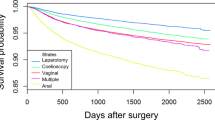Abstract
Objective
To identify the incidence and risk factors of gastrointestinal injury (GITI) related to pelvic organ prolapse (POP) surgery.
Methods
Women who underwent POP surgery between 2000 and 2020 were identified in the Premier Healthcare Database. The primary outcome was GITI, defined as small or large bowel injury or repair, and fistula or fistula repair. Differences between patients with and without GITI were evaluated, and a multivariable regression was performed to determine independent predictors of GITI.
Results
We identified 563,661 index POP surgeries in female patients aged 18 years and older. Of these, 4582 (0.8%) had a bowel injury code within 1 year of index POP surgery. Patients who experienced GITI were more likely to be younger (49.9 ± 12.8 vs 50.9 ± 13.7), and receive surgery with a surgeon who performed less than 12 surgeries per year (48% vs 42%). Most GITI was diagnosed in the same month (73.4%) and same hospital encounter (54%) as index POP surgery. After adjusting for confounders, lysis of adhesions (aOR = 2.03, 95% CI: 1.48–2.72) and perioperative hematoma/hemorrhage (aOR = 2.87, 95%C I: 1.70–4.59) were strongly associated with GITI, while having surgery with a surgeon performing > 50 POP surgeries per year (aOR = 0.66, 95%C I: 0.59–0.75 and concomitant obliterative procedures (aOR = 0.48, 95% CI: 0.34–0.65) were associated with a lower probability of GITI.
Conclusions
The rate of GITI after POP surgery is less than 1%, and injuries are commonly diagnosed and treated in the same month as index surgery. High-volume surgeons and obliterative procedures may be protective against GITI.
Similar content being viewed by others
References
Clarke-Pearson DL, Geller EJ. Complications of hysterectomy. Obstet Gynecol. 2013;121(3):654–73. https://doi.org/10.1097/AOG.0b013e3182841594.
Lefebvre G, Devenny KA, Héroux DL, et al. Intraoperative injuries from abdominopelvic surgery: an analysis of national medicolegal data. Can J Surg. 2021;64(2):E127–34. https://doi.org/10.1503/cjs.010219.
Llarena NC, Shah AB, Milad MP. Bowel injury in gynecologic laparoscopy: a systematic review. Obstet Gynecol. 2015;125(6):1407–17. https://doi.org/10.1097/aog.0000000000000855.
Zhu CR, Mallick R, Singh SS, et al. Risk factors for bowel injury in hysterectomy for benign indications. Obstet Gynecol. 2020;136(4):803–10. https://doi.org/10.1097/aog.0000000000004007.
Whitehead WE, Bradley CS, Brown MB, et al. Gastrointestinal complications following abdominal sacrocolpopexy for advanced pelvic organ prolapse. Am J Obstet Gynecol. 2007;197(1):78. https://doi.org/10.1016/j.ajog.2007.02.046. (e1-7).
Nygaard IE, McCreery R, Brubaker L, et al. Abdominal sacrocolpopexy: a comprehensive review. Obstet Gynecol. 2004;104(4):805–23. https://doi.org/10.1097/01.Aog.0000139514.90897.07.
Anand M, Woelk JL, Weaver AL, Trabuco EC, Klingele CJ, Gebhart JB. Perioperative complications of robotic sacrocolpopexy for post-hysterectomy vaginal vault prolapse. Int Urogynecol J. 2014;25(9):1193–200. https://doi.org/10.1007/s00192-014-2379-9.
Premier Applied Sciences® PI. Premier Healthcare Database White Paper: data that informs and performs. Premier Applied Sciences® , the Research Division of Premier Inc. 2020. https://learn.premierinc.com/white-papers/premier-healthcaredatabase-whitepaper.
Vehtari A, Gelman A, Simpson D, Carpenter B, Bürkner P-C. Rank-normalization, folding, and localization: an improved $\widehat{R}$ for assessing convergence of MCMC (with discussion). Bayesian Anal. 2021;16(2):667–718
Bürkner P-C. brms: an R package for Bayesian multilevel models using Stan. J Stat Softw. 2017;80(1):1–28. https://doi.org/10.18637/jss.v080.i01.
Aarts JW, Nieboer TE, Johnson N, et al. Surgical approach to hysterectomy for benign gynaecological disease. Cochrane Database Syst Rev. 2015;2015(8):Cd003677. https://doi.org/10.1002/14651858.CD003677.pub5.
Sharp HT, Swenson C. Hollow viscus injury during surgery. Obstet Gynecol Clin North Am. 2010;37(3):461–7. https://doi.org/10.1016/j.ogc.2010.05.004.
Warner WB, Vora S, Alonge A, Welgoss JA, Hurtado EA, von Pechmann WS. Intraoperative and postoperative gastrointestinal complications associated with laparoscopic sacrocolpopexy. Female Pelvic Med Reconstr Surg. 2012;18(6):321–4. https://doi.org/10.1097/SPV.0b013e3182724648.
Sheyn D, Gupta A, Boyd S, Wu X, Shoag J, Bretschneider CE. Incidence and risk factors for genitourinary tract injury within 1 year after surgery for pelvic organ prolapse. Urogynecology. 2022;28(8):506–17. https://doi.org/10.1097/spv.0000000000001201.
Mowat A, Maher C, Ballard E. Surgical outcomes for low-volume vs high-volume surgeons in gynecology surgery: a systematic review and meta-analysis. Am J Obstet Gynecol. 2016;215(1):21–33. https://doi.org/10.1016/j.ajog.2016.02.048.
Acknowledgements
The abstract for this manuscript has been accepted as a non-oral poster at the Society for Gynecologic Surgeons Annual Meeting in Tucson, AZ, USA to be held in March 2023.
Author information
Authors and Affiliations
Contributions
A Gupta: Project development, manuscript writing/editing.
CE Bretschneider: Project development, manuscript editing.
S Rhodes: Data analysis, manuscript editing.
J Shoag: Project development, manuscript editing.
C McBride: Project development, manuscript editing.
D Sheyn: Project development, manuscript writing/editing.
Corresponding author
Ethics declarations
Conflicts of interest
A Gupta: None.
CE Bretschneider: Consultant for Boston Scientific.
S Rhodes: None.
J Shoag: None.
C McBride: None.
D Sheyn: research funding: Renalis, NICHD, AHRQ; consulting fee: Caldera Medical.
Additional information
Publisher's note
Springer Nature remains neutral with regard to jurisdictional claims in published maps and institutional affiliations.
Supplementary Information
Below is the link to the electronic supplementary material.
Rights and permissions
Springer Nature or its licensor (e.g. a society or other partner) holds exclusive rights to this article under a publishing agreement with the author(s) or other rightsholder(s); author self-archiving of the accepted manuscript version of this article is solely governed by the terms of such publishing agreement and applicable law.
About this article
Cite this article
Gupta, A., Bretschneider, C.E., Rhodes, S. et al. Evaluation of gastrointestinal tract injury within 1 year of surgery for pelvic organ prolapse. Int Urogynecol J 34, 2061–2065 (2023). https://doi.org/10.1007/s00192-023-05503-7
Received:
Accepted:
Published:
Issue Date:
DOI: https://doi.org/10.1007/s00192-023-05503-7




